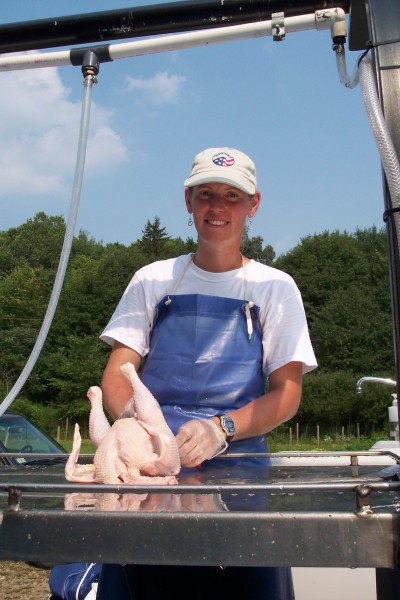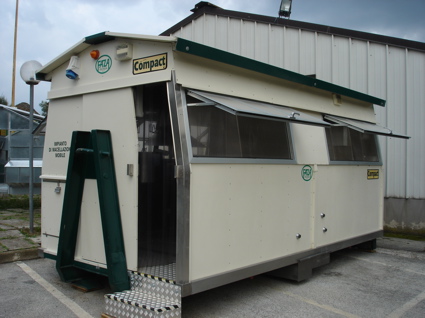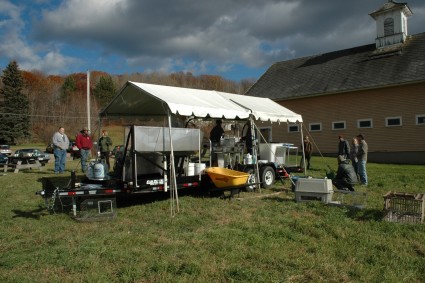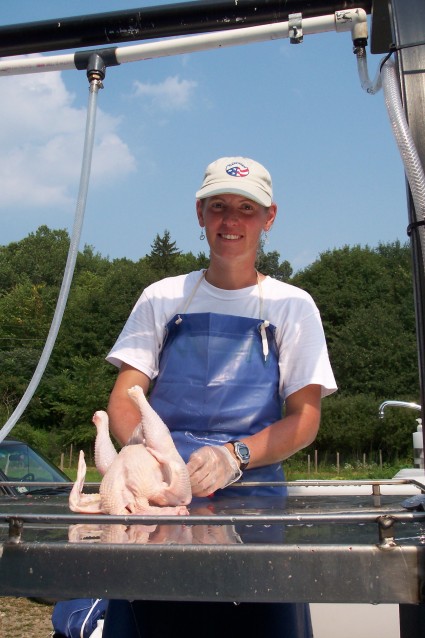 Jennifer Hashley processes a chicken on her Massachusetts farm. Massachusetts poultry farmer Jennifer Hashley has a problem. From the moment she started raising pastured chickens outside Concord, Mass. in 2002, there was, as she put it “nowhere to go to get them processed.” While she had the option of slaughtering her chickens in her own backyard, Hashley knew that selling her chickens would be easier if she used a licensed slaughterhouse. Nor is she alone in her troubles. Despite growing demand for local, pasture-raised chickens, small poultry producers throughout Massachusetts, Connecticut, and even New York can’t or won’t expand for lack of processing capacity.
Jennifer Hashley processes a chicken on her Massachusetts farm. Massachusetts poultry farmer Jennifer Hashley has a problem. From the moment she started raising pastured chickens outside Concord, Mass. in 2002, there was, as she put it “nowhere to go to get them processed.” While she had the option of slaughtering her chickens in her own backyard, Hashley knew that selling her chickens would be easier if she used a licensed slaughterhouse. Nor is she alone in her troubles. Despite growing demand for local, pasture-raised chickens, small poultry producers throughout Massachusetts, Connecticut, and even New York can’t or won’t expand for lack of processing capacity.
It isn’t only small producers who are feeling the pinch — a widespread lack of processing infrastructure appropriate for small farmers has caused supply chain problems for the big retailers as well. Whole Foods — the world’s largest natural-foods supermarket — wants to aggressively expand its local meat sourcing, according to its head meat buyer, Theo Weening. But it faces the same limitation as Hashley. Most regions of the country have “lots of agriculture but nowhere to process,” Weening told me, adding that the phenomenon is most acute in the northeast.
Whole Foods wants to change all that. In a move that has national implications, the retail giant has confirmed to Grist that it is working with the USDA as well as state authorities to establish a fleet of top-of-the-line “mobile slaughterhouses” for chicken. Starting with a single unit serving Massachusetts, Connecticut, and the Hudson Valley, N.Y. area, Whole Foods hopes to offer small farmers an affordable way to process chickens as well as to vastly increase the amount of locally-sourced chicken it sells. If successful, this program could be expanded to any region of the country with similar infrastructure shortages.
Consolidation Is for the (Big) Birds
That Whole Foods would undertake a move into meat processing serves to underscore the extent of the meat industry’s consolidation. Today, 90 percent of beef processing, 70 percent of pork processing and nearly 60 percent of poultry processing are handled by the top four companies in each sector (with new mergers occuring almost monthly). As processing giants like Tyson scale up and buy competitors, they shutter smaller facilities. Farmers like Hashley have to truck their livestock dozens — sometimes up to a hundred — miles to get to the nearest slaughterhouse for the privilege of paying premium prices to process a small herd. And in some cases, small producers can’t get access to these large facilities at any price; they simply won’t accommodate small growers, often due to rigid “biosecurity” protocols.
What might be an inconvenience transforms into a Catch-22 considering the maze of requirements for the legal sale of meat — this is not an area where DIY is easy or welcome. Generally speaking only meat processed at USDA-inspected facilities can be sold to the public. About half of all states allow for state inspectors to stand in for federal inspectors, but even then, that meat may only be sold within state lines. Poultry farmers are somewhat exempted from this — they can process some of their own birds on the farm and then sell them directly to consumers. But, with a few state-specific exceptions, beef, pork, and lamb simply may not be sold — even direct farm-to-consumer — unless it has been processed at a state or federally inspected slaughterhouse.
Given the high costs and uncertain prospects of building new small-scale slaughterhouses, there is a growing interest among farmers in these mobile slaughterhouses–interest that got Whole Foods’ attention in the first place. Currently, many farmers rely on on-farm slaughter by “ranch killers,” such as one in California profiled recently profiled by Mother Jones. But there are many legal restrictions on how and where such meat can be sold, so they often end up operating in a legal gray area. USDA-certified mobile slaughterhouses–complete with a permanently assigned USDA inspector–are a much better solution, and are beginning to pop up around the U.S. The first such approved unit operates on a small island off the coast of Washington state. Bruce Dunlop, the farmer/engineer who built it for a farmer co-op, now sells plans and kits. He also consults on the paperwork process for gaining USDA-inspected status.
If Whole Foods’ mobile-slaughterhouse strategy succeeds, this farmer-friendly method of processing birds will come into its own. To some, it’s a welcome effort to increase options for farmers. To others, it’s an ominous sign that the government is siding with a powerful retailer in a way that will, intentionally or not, squeeze farmers even more.
 An Italian-made mobile-processing unit, of the type Whole Foods is considering. Photo courtesy of Whole FoodsWhole Foods to the Rescue?
An Italian-made mobile-processing unit, of the type Whole Foods is considering. Photo courtesy of Whole FoodsWhole Foods to the Rescue?
Whole Foods’ Weening, architect of the initiative, doesn’t see it that way. He only sees the difficulties small producers have with getting their chickens processed at large slaughterhouses. For him, if Whole Foods can help the little guy while also providing an expanded market for locally-produced meat, everyone wins.
And experts in local agriculture are tempted to agree. Mary Hendrickson, a rural sociologist who specializes in regional food systems at the University of Missouri, told me that “processing capacity is an absolutely critical link that we’ve struggled to fill — mobile slaughtering has a hope of filling the gap.”
Weening is certainly trying to do just that. The mobile units aren’t designed as a money-maker for Whole Foods. While Whole Foods will have a minimum “buy” of around 500 chickens, farmers who sell chickens to Whole Foods will be able to process as many birds as they want with the unit. Since the processing cost will be included in the price Whole Food pays the farmer, processing of additional chickens will essentially be free. Crucially, Weening also intends to allow farmers who don’t sell to Whole Foods use of the mobile units (though pricing is yet to be determined). Farmers can then sell those chickens however they like — to other retailers (remember, it would be USDA certified), at farmers markets, or directly on the farm. If all goes to plan, the first Whole Foods’ processing unit will be on the road and operating by May 2010.
But support for Whole Foods effort is not universal. There is growing concern over the power large national retailers have over farmers, and the prospect of Whole Foods moving into the meat processing business does little to allay it. Fred Stokes, executive director of the Organization for Competitive Markets, a group dedicated to resisting agricultural consolidation, lauded Whole Foods for trying to provide an alternative to the large slaughterhouses, but suggested that individual farmers lacked the power to go toe to toe with such a dominant player. Hendrickson also questioned how small farmers could “maintain their competitive bargaining position” with an entity as powerful as Whole Foods.
Stokes — along with Fred Kirschenmann, a farmer as well as a leading advocate for sustainable agriculture and president of the Stone Barns Center for Food and Agriculture in upstate New York — took serious issue with one significant element of Whole Foods plan: the set of very specific guidelines any farmer who hopes to sell to Whole Foods will have to follow. To Whole Foods’ Weening, this is about providing a “consistent” product to consumers; to ensure that all Whole Foods chickens — in Weening’s words — “look and taste the same.” Weening explained that the company will require participating small farmers to raise a specific breed of chicken supplied by a specific (local) breeder, feed them a specific brand of feed (no antibiotics or animal byproducts allowed) and raise them according to Whole Foods standard poultry production style, which requires “access to pasture” but does not require actually keeping the birds on pasture.
Big Buyer, Small Seller
These experts expressed concerns that, despite Whole Foods’ good intentions, such a strict set of guidelines when applied to small farmers put the whole enterprise dangerously close to “contract farming.” In contract farming, a farmer raises birds under contract for sale to a large processor like Tyson Foods or Purdue. With large processors like Tyson, the farmer doesn’t even own the birds, but is still responsible for the land, the equipment and all the infrastructure required to raise the animals, often making significant investments to satisfy the needs of the processor. But if the processor ultimately refuses the sale for whatever reason (and these contracts are very favorable to the processor), there is no backup plan. The farmer raised the birds specifically to satisfy the contract. Without the sale, it’s a total loss. In such cases, the farmer has a nasty tendency to go bankrupt. Too often, farmers “essentially become,” as OCM’s Stokes put it, “indentured servants on their own land.”
Now, Whole Foods denied that it has any interest in “contract farming” — there will be no contracts signed in advance — and the company strongly asserts that it is trying to give small farmers more options, not fewer. But Hashley, the Massachussetts farmer, painted a scenario whereby small East Coast farmers are forced by Whole Foods to compete on price with the large scale “natural” poultry growers in California that currently supply the retailer’s stores. If that’s the case, according to Hashley, farmers may find themselves pushed to expand their operations, making up on volume what they can’t make per bird, and investing large sums of money in chicks, feed, and even barns with only Whole Foods as a buyer. If Whole Foods then refuses the sale for a declared violation of one of its guidelines, the financial loss to the farmer will be disastrous.
Hashley is clearly skeptical that partnering with Whole Foods is a good idea for individual small farmers. And worst of all in her view, Whole Foods guidelines will effectively preclude pasture-raised birds. With space in Massachusetts, and most of the northeast at a premium for farmers, providing adequate supply to a buyer the size of Whole Foods will inevitably lead farmers to move their birds indoors, since barn-raised chickens can be more densely packed. Aside from the financial implications, Hashley resented the idea of replicating the Whole Foods “access to pasture”-style of intensive poultry production: birds that in reality rarely if ever step outside despite an open barn door.
Tipping the Scale
There are, of course, alternatives to a reliance on Whole Foods as a local food enabler. Hashley herself has been working hard with state regulators and local boards of health to create a farmer-owned solution to the infrastructure problem, which she had hoped would be funded by a USDA Rural Development grant. As I finished reporting for this article, Hashley learned (and I confirmed) that her grant proposal will be rejected, though she continues to seek funding from other sources. Hashley passionately believes that a farmer cooperative should own the processing units, which would initially be certified by the state for direct sales by farmers (i.e. at farmers markets or on the farm) but not for sale to retailers. Small farmers would no longer have to haul their chickens halfway across the state for processing, but they would still have to sell their birds directly — something that many farmers are happy to do. Over time and with the coops having proved the model, USDA certification and inspection could follow. In any event, access to the unit would not be controlled by a private entity with a substantial financial interest in how it’s used.
Resolving these sorts of market-oriented conflicts and helping farmers is, of course, the role of state and federal regulators. Where do they stand on the Whole Foods effort? Jay Healy, Massachusetts State Director for USDA Rural Development, the office that turned down Hashley’s grant proposal, is more sanguine about Whole Foods’ effort. One obvious appeal: unlike Hashley, the retailer isn’t asking for any federal money for its initiative. Healy also praised Whole Foods “state of the art,” stainless steel, Italian-built unit, a version of which already has regulatory approval in Europe, for addressing to his satisfaction all the relevant food safety and environmental concerns. While Healy appreciates the coop’s efforts and hopes to fund them in the future, he felt that their unit still needed further refinement. The Whole Foods unit seems to him poised to get federal certification, which is the ultimate goal if mobile slaughterhouses are to become a mainstream solution.
Healy’s was exactly the response that Hashley herself feared when she first got word of the Whole Foods proposal. Aside from her concerns about the guidelines, Hashley doesn’t have a blanket objection to Whole Foods effort overall since her processing options are virtually non-existent. But she is concerned that, Healy’s statement notwithstanding, state and federal regulators will eventually lose total interest in working with farmer cooperatives as a result of the Whole Foods’ move into small-scale processing. Like the other experts I talked to, she’s also deeply skeptical of relying on Whole Foods’ good intentions. While a breakeven project now, the company’s processing units may transform into a revenue center later, which would be a threatening development for farmers.
 Small is beautiful, but not always enough: Hashley’s on-farm processing unit. The good news for Hashley is that Massachusetts’ top agricultural official Scott Soares appears to share her concerns. In a recent meeting with Whole Foods, Soares strongly encouraged the company to work with the farmer coops to avoid a conflict over the dueling proposals. He wants to be “certain we have a level playing field for all the players out there.” That means balancing the concerns of farmers as well as the interests of Whole Foods. Soares has requested detailed information from Whole Foods on its inititative, including pricing and provisions for access to the units, and emphasized in his discussions that coops do have an important role to play. While Soares has a limited regulatory role in approving the unit, he will continue to seek assurances that Whole Foods will operate fairly and in good faith.
Small is beautiful, but not always enough: Hashley’s on-farm processing unit. The good news for Hashley is that Massachusetts’ top agricultural official Scott Soares appears to share her concerns. In a recent meeting with Whole Foods, Soares strongly encouraged the company to work with the farmer coops to avoid a conflict over the dueling proposals. He wants to be “certain we have a level playing field for all the players out there.” That means balancing the concerns of farmers as well as the interests of Whole Foods. Soares has requested detailed information from Whole Foods on its inititative, including pricing and provisions for access to the units, and emphasized in his discussions that coops do have an important role to play. While Soares has a limited regulatory role in approving the unit, he will continue to seek assurances that Whole Foods will operate fairly and in good faith.
But Healy’s and Soares’ comments make clear that, while Whole Foods is neither enemy nor savior for farmers, the danger is real that state regulators and the USDA will view large processors and large retailers as their ideal partners. Ag experts like Stokes, Hendricksen, and Kirschenmann all agree that regulators should instead side with farmer coops as entities best suited to counterbalance the market power of industry giants, even well-intentioned ones like Whole Foods.
It’s also clear that no one really wants to stop Whole Foods’ move into meat processing — though that fact has more to do with the lack of processing infrastructure than with Whole Foods itself. And the retail giant’s initiative may yet collapse if the USDA proves unwilling to certify the units themselves. But should Whole Foods succeed and launch mobile slaughterhouses, regulators, farmers, and consumers will be relying on a corporate behemoth to address problems created by the existence of other, larger behemoths. While it may be the best available solution to an entrenched problem, it doesn’t seem a robust one.

